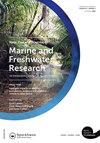从海洋到山脉:量化淡水鳗鱼和鳟鱼的饮食依赖上游洄游鱼类的海洋补贴
IF 1.7
4区 环境科学与生态学
Q3 FISHERIES
New Zealand Journal of Marine and Freshwater Research
Pub Date : 2022-07-03
DOI:10.1080/00288330.2022.2101482
引用次数: 6
摘要
尽管南半球特有的二产卵鱼类比例很高,但上游洄游饲料鱼在淡水生态系统中的营养作用仍未量化。我们将食物网δ13C和δ15N分析与鱼类生物量估算相结合,量化了2019年和2021年期间(来自具有重要生态意义的怀图纳泻湖)对新西兰奥特罗阿南地怀图纳溪的顶级捕食者长鳍鳗(Anguilla dieffenbachii)和褐鳟(Salmo trutta)的饮食和生长的河口资源贡献。我们的研究结果表明,在退化的农业集水区,通过与近乎原始的河口泻湖的连接,大型掠食性鱼类的生物量(610-830 kg km−1)保持了异常高的水平。在两年的采样中,从泻湖上游迁移的Īnanga (Galaxias maculatus)支持了60%-80%的长鳍鳗和40%-90%的褐鳟生物量。质量平衡模型显示,怀图纳溪的大型掠食性鱼类每年吃掉大约两吨迁徙的银鱼。这些发现强调了河口/海洋补贴在构建新西兰淡水食物网中的更广泛作用,并挑战了“从源头恢复溪流”的正统观念。在食物有限的情况下,河口生态系统对于维持大型掠食性鱼类(如长鳍鳗鱼)的生存可能比水源地区更为重要。本文章由计算机程序翻译,如有差异,请以英文原文为准。
Sea to the mountains: quantifying freshwater eel and trout diet reliance on marine subsidies from upstream migrating fish
ABSTRACT Despite the Southern Hemisphere’s high proportion of endemic diadromous fish, the trophic role of upstream migrating forage fish in freshwater ecosystems remains unquantified. We combined food web δ13C and δ15N analyses with fish biomass estimates to quantify estuarine resource contribution (from the ecologically significant Waituna lagoon) to the diet and growth of the apex predators, longfin eels (Anguilla dieffenbachii) and brown trout (Salmo trutta) in Waituna Creek, Southland, Aotearoa (New Zealand) during 2019 and 2021. Our results demonstrated that exceptionally high biomasses of large predatory fishes (610–830 kg km−1) were maintained in a degraded agricultural catchment through connectivity to a near-pristine estuarine lagoon. Īnanga (Galaxias maculatus) migrating upstream from the lagoon supported 60%–80% of longfin eel and 40%–90% of brown trout biomass over the two years sampled. Mass-balance modelling suggested that large predatory fish in the Waituna Creek consume about two tonnes of migrating whitebait annually. These findings highlight the wider role of estuarine/marine subsidies in structuring New Zealand freshwater food webs and challenge the orthodoxy of ‘restoring streams from the headwaters down’. Estuarine ecosystems may be more important than headwater areas for sustaining large predatory fish, such as longfin eels, when they are food limited.
求助全文
通过发布文献求助,成功后即可免费获取论文全文。
去求助
来源期刊
CiteScore
4.50
自引率
12.50%
发文量
35
审稿时长
3 months
期刊介绍:
Aims: The diversity of aquatic environments in the southern continents and oceans is of worldwide interest to researchers and resource managers in research institutions, museums, and other centres. The New Zealand Journal of Marine and Freshwater Research plays an important role in disseminating information on observational, experimental, theoretical and numerical research on the marine, estuarine and freshwater environments of the region.

 求助内容:
求助内容: 应助结果提醒方式:
应助结果提醒方式:


